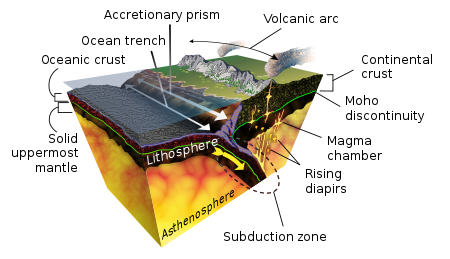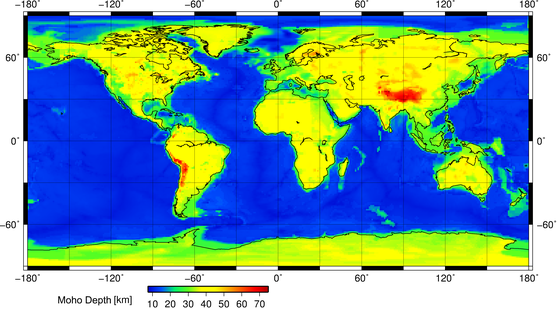Mohorovičić discontinuity
The Mohorovičić discontinuity (Croatian pronunciation: [moxorôʋiːt͡ʃit͡ɕ]),[1] usually referred to as the Moho, is the boundary between the Earth's crust and the mantle. It is defined by the distinct change in velocity of seismological waves as they pass through changing densities of rock.[2]

The Moho lies almost entirely within the lithosphere.[3] Only beneath mid-ocean ridges does it define the lithosphere–asthenosphere boundary. The Mohorovičić discontinuity is 5 to 10 kilometres (3–6 mi) below the ocean floor, and 20 to 90 kilometres (10–60 mi) beneath typical continental crusts, with an average of 35 kilometres (22 mi).
Named after the pioneering Croatian seismologist Andrija Mohorovičić, the Moho separates both the oceanic crust and continental crust from underlying mantle. The Mohorovičić discontinuity was first identified in 1909 by Mohorovičić, when he observed that seismograms from shallow-focus earthquakes had two sets of P-waves and S-waves, one that followed a direct path near the Earth's surface and the other refracted by a high-velocity medium.[4]
Nature and seismology

The Moho marks the transition in composition between the Earth's rocky outer crust and the more plastic mantle. Immediately above the Moho, the velocities of primary seismic waves (P-waves) are consistent with those through basalt (6.7–7.2 km/s), and below they are similar to those through peridotite or dunite (7.6–8.6 km/s).[5] This increase of approximately 1 km/s corresponds to a distinct change in material as the waves pass through the Earth, and is commonly accepted as the lower limit of the Earth's crust.[6] The Moho is characterized by a transition zone of up to 500 meters.[7] Ancient Moho zones are exposed above-ground in numerous ophiolites around the world.[8]

History
Croatian seismologist Andrija Mohorovičić is credited with first discovering and defining the Moho.[9] In 1909, he was examining data from a local earthquake in Zagreb when he observed two distinct sets of P-waves and S-waves propagating out from the focus of the earthquake. Mohorovičić knew that waves caused by earthquakes travel at velocities proportional to the density of the material carrying them. As a result of this information, he theorized that the second set of waves could only be caused by a sharp transition in density in the Earth's crust, which could account for such a dramatic change in wave velocity. Using velocity data from the earthquake, he was able to calculate the depth of the Moho to be approximately 54 km, which was later supported by future seismological studies.[10]
The Moho has played a large role in the fields of geology and earth science for well over a century. By observing the Moho's refractive nature and how it affects the speed of P-waves, scientists were able to theorize about the earth's composition. These early studies gave rise to modern seismology.[10]
In the early 1960s, Project Mohole was an attempt to drill to the Moho from deep-ocean regions.[11] After initial success in establishing deep-ocean drilling, the project suffered from political and scientific opposition, mismanagement, and cost overruns, and it was cancelled in 1966.[12]
Exploration
Reaching the discontinuity by drilling remains an important scientific objective. Soviet scientists at the Kola Institute pursued the goal in 1989. After 15 years they reached a depth of 12,260 metres (40,220 ft), the world's deepest hole, before abandoning the project.[13] One proposal considers a rock-melting radionuclide-powered capsule with a heavy tungsten needle that can propel itself down to the Moho discontinuity and explore Earth's interior near it and in the upper mantle.[14] The Japanese project Chikyu Hakken ("Earth Discovery") also aims to explore in this general area with the drilling ship, Chikyū, built for the Integrated Ocean Drilling Program (IODP).
Plans called for the drill-ship JOIDES Resolution to sail from Colombo in Sri Lanka in late 2015 and to head for the Atlantis Bank, a promising location in the southwestern Indian Ocean on the Southwest Indian Ridge, to attempt to drill an initial bore hole to a depth of approximately 1.5 kilometres.[15] The attempt did not even reach 1.3 km, but researchers hope to further their investigations at a later date.[16]
See also
- Brittle–ductile transition zone – The strongest part of the Earth's crust
- Core–mantle boundary – Discontinuity where the bottom of the planet's mantle meets the outer layer of the core
- Kola Superdeep Borehole – A scientific deep drilling project of the Soviet Union on the Kola Peninsula
- Lehmann discontinuity – An abrupt increase of P-wave and S-wave velocities at the depth of 220±30 km
Notes
- Mangold, Max (2005). Aussprachewörterbuch (in German) (6th ed.). Mannheim: Dudenverlag. p. 559. ISBN 9783411040667.
- Rudnick, R. L.; Gao, S. (2003-01-01), Holland, Heinrich D.; Turekian, Karl K. (eds.), "3.01 - Composition of the Continental Crust", Treatise on Geochemistry, Pergamon, pp. 1–64, doi:10.1016/b0-08-043751-6/03016-4, ISBN 978-0-08-043751-4, retrieved 2019-11-21
- James Stewart Monroe; Reed Wicander (2008). The changing Earth: exploring geology and evolution (5th ed.). Cengage Learning. p. 216. ISBN 978-0-495-55480-6.
- Andrew McLeish (1992). Geological science (2nd ed.). Thomas Nelson & Sons. p. 122. ISBN 978-0-17-448221-5.
- RB Cathcart & MM Ćirković (2006). Viorel Badescu; Richard Brook Cathcart & Roelof D Schuiling (eds.). Macro-engineering: a challenge for the future. Springer. p. 169. ISBN 978-1-4020-3739-9.
- Rudnick, R.L.; Gao, S. (2003), "Composition of the Continental Crust", Treatise on Geochemistry, Elsevier, pp. 1–64, doi:10.1016/b0-08-043751-6/03016-4, ISBN 978-0-08-043751-4
- D.P. McKenzie - The Mohorovičić Discontinuity
- Korenaga, Jun; Kelemen, Peter B. (1997-12-10). "Origin of gabbro sills in the Moho transition zone of the Oman ophiolite: Implications for magma transport in the oceanic lower crust". Journal of Geophysical Research: Solid Earth. 102 (B12): 27729–27749. doi:10.1029/97JB02604.
- Braile, L. W.; Chiangl, C. S. (1986), Barazangi, Muawia; Brown, Larry (eds.), "The continental Mohorovičič Discontinuity: Results from near-vertical and wide-angle seismic reflection studies", Geodynamics Series, American Geophysical Union, 13, pp. 257–272, doi:10.1029/gd013p0257, ISBN 978-0-87590-513-6
- Prodehl, Claus; Mooney, Walter D. (2012). Exploring the Earth's Crust—History and Results of Controlled-Source Seismology. doi:10.1130/mem208. ISBN 9780813712086.
- Winterer, Edward L. (2000). "Scientific Ocean Drilling, from AMSOC to COMPOST". 50 Years of Ocean Discovery: National Science Foundation 1950-2000. Washington, D.C.: National Academies Press (US).
- Mohole, LOCO, CORE, and JOIDES: A brief chronology Betty Shor, The Scripps Institution of Oceanography, August 1978, 7 pp. Access date 25 June 2019.
- "How the Soviets Drilled the Deepest Hole in the World". Wired. 2008-08-25. Retrieved 2008-08-26.
- Ozhovan, M.; F. Gibb; P. Poluektov & E. Emets (August 2005). "Probing of the Interior Layers of the Earth with Self-Sinking Capsules". Atomic Energy. 99 (2): 556–562. doi:10.1007/s10512-005-0246-y.
- Witze, Alexandra (December 2015). "Quest to drill into Earth's mantle restarts". Nature News. 528 (7580): 16–17. Bibcode:2015Natur.528...16W. doi:10.1038/528016a. PMID 26632566.
-
Kavanagh, Lucas (2016-01-27). "Looking Back on Expedition 360". JOIDES Resolution. Archived from the original on 2016-07-09. Retrieved 2016-09-21.
We may not have made it to our goal of 1300 m, but we did drill the deepest ever single-leg hole into hard rock (789 m), which is currently the 5th deepest ever drilled into the hard ocean crust. We also obtained both the longest (2.85 m) and widest (18 cm) single pieces of hard rock ever recovered by the International Ocean Discovery Program and its predecessors! [...] Our hopes are high to return to this site in the not too distant future.
References
- Harris, P. (1972). "The composition of the earth". In Gass, I. G.; et al. (eds.). Understanding the earth: a reader in the earth sciences. Horsham: Artemis Press for the Open University Press. ISBN 978-0-85141-308-2.
- "Schlumberger Oilfield Glossary". Schlumberger. Retrieved 2008-07-17.
- Dixon, Dougal (2000). Beginner's Guide to Geology. New York: Bounty Books. ISBN 978-0-7537-0358-8.
External links
- Britt, Robert Roy (2005-04-07). "Hole Drilled to Bottom of Earth's Crust, Breakthrough to Mantle Looms". Imaginova. Retrieved 2008-07-17.
- "Digging a Hole in the Ocean: Project Mohole, 1958-1966". National Academy of Sciences. Archived from the original on 2015-11-02. Retrieved 2008-07-17.
- Map of the Moho depth of the European plate

